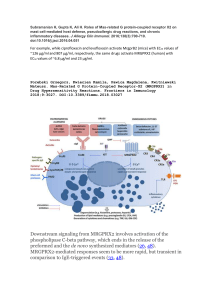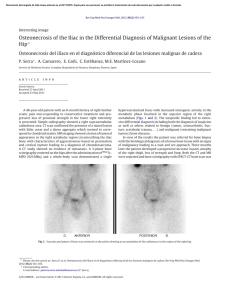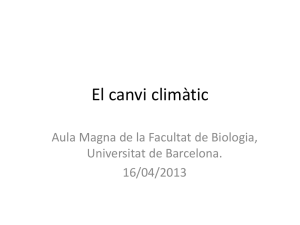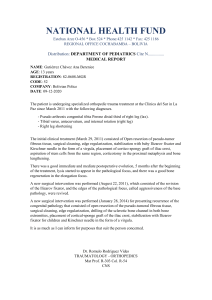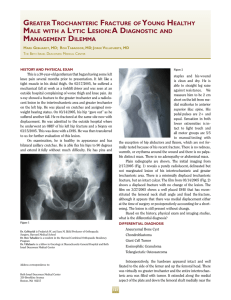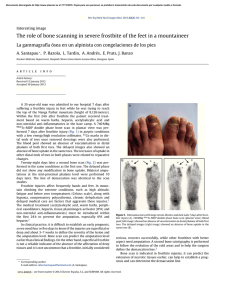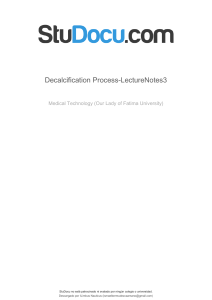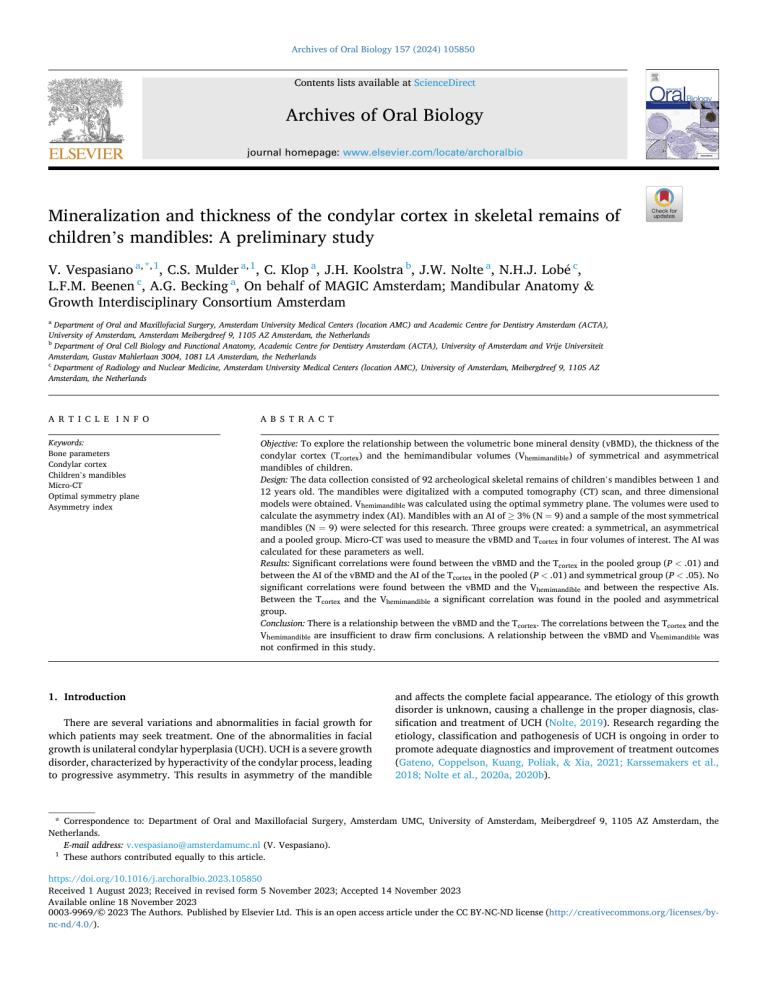
Archives of Oral Biology 157 (2024) 105850 Contents lists available at ScienceDirect Archives of Oral Biology journal homepage: www.elsevier.com/locate/archoralbio Mineralization and thickness of the condylar cortex in skeletal remains of children’s mandibles: A preliminary study V. Vespasiano a, *, 1, C.S. Mulder a, 1, C. Klop a, J.H. Koolstra b, J.W. Nolte a, N.H.J. Lobé c, L.F.M. Beenen c, A.G. Becking a, On behalf of MAGIC Amsterdam; Mandibular Anatomy & Growth Interdisciplinary Consortium Amsterdam a Department of Oral and Maxillofacial Surgery, Amsterdam University Medical Centers (location AMC) and Academic Centre for Dentistry Amsterdam (ACTA), University of Amsterdam, Amsterdam Meibergdreef 9, 1105 AZ Amsterdam, the Netherlands Department of Oral Cell Biology and Functional Anatomy, Academic Centre for Dentistry Amsterdam (ACTA), University of Amsterdam and Vrije Universiteit Amsterdam, Gustav Mahlerlaan 3004, 1081 LA Amsterdam, the Netherlands c Department of Radiology and Nuclear Medicine, Amsterdam University Medical Centers (location AMC), University of Amsterdam, Meibergdreef 9, 1105 AZ Amsterdam, the Netherlands b A R T I C L E I N F O A B S T R A C T Keywords: Bone parameters Condylar cortex Children’s mandibles Micro-CT Optimal symmetry plane Asymmetry index Objective: To explore the relationship between the volumetric bone mineral density (vBMD), the thickness of the condylar cortex (Tcortex) and the hemimandibular volumes (Vhemimandible) of symmetrical and asymmetrical mandibles of children. Design: The data collection consisted of 92 archeological skeletal remains of children’s mandibles between 1 and 12 years old. The mandibles were digitalized with a computed tomography (CT) scan, and three dimensional models were obtained. Vhemimandible was calculated using the optimal symmetry plane. The volumes were used to calculate the asymmetry index (AI). Mandibles with an AI of ≥ 3% (N = 9) and a sample of the most symmetrical mandibles (N = 9) were selected for this research. Three groups were created: a symmetrical, an asymmetrical and a pooled group. Micro-CT was used to measure the vBMD and Tcortex in four volumes of interest. The AI was calculated for these parameters as well. Results: Significant correlations were found between the vBMD and the Tcortex in the pooled group (P < .01) and between the AI of the vBMD and the AI of the Tcortex in the pooled (P < .01) and symmetrical group (P < .05). No significant correlations were found between the vBMD and the Vhemimandible and between the respective AIs. Between the Tcortex and the Vhemimandible a significant correlation was found in the pooled and asymmetrical group. Conclusion: There is a relationship between the vBMD and the Tcortex. The correlations between the Tcortex and the Vhemimandible are insufficient to draw firm conclusions. A relationship between the vBMD and Vhemimandible was not confirmed in this study. 1. Introduction There are several variations and abnormalities in facial growth for which patients may seek treatment. One of the abnormalities in facial growth is unilateral condylar hyperplasia (UCH). UCH is a severe growth disorder, characterized by hyperactivity of the condylar process, leading to progressive asymmetry. This results in asymmetry of the mandible and affects the complete facial appearance. The etiology of this growth disorder is unknown, causing a challenge in the proper diagnosis, clas­ sification and treatment of UCH (Nolte, 2019). Research regarding the etiology, classification and pathogenesis of UCH is ongoing in order to promote adequate diagnostics and improvement of treatment outcomes (Gateno, Coppelson, Kuang, Poliak, & Xia, 2021; Karssemakers et al., 2018; Nolte et al., 2020a, 2020b). * Correspondence to: Department of Oral and Maxillofacial Surgery, Amsterdam UMC, University of Amsterdam, Meibergdreef 9, 1105 AZ Amsterdam, the Netherlands. E-mail address: [email protected] (V. Vespasiano). 1 These authors contributed equally to this article. https://doi.org/10.1016/j.archoralbio.2023.105850 Received 1 August 2023; Received in revised form 5 November 2023; Accepted 14 November 2023 Available online 18 November 2023 0003-9969/© 2023 The Authors. Published by Elsevier Ltd. This is an open access article under the CC BY-NC-ND license (http://creativecommons.org/licenses/bync-nd/4.0/). V. Vespasiano et al. Archives of Oral Biology 157 (2024) 105850 The volumetric bone mineral density (vBMD) could play a role in the process of diagnosing and treating facial asymmetries, such as UCH. In condylar bone it could provide information about turnover rates and heterogeneity of the mineralization (Renders, Mulder, van Ruijven, & van Eijden, 2006). In case of a high bone remodeling rate, the average tissue mineralization decreases whereas the heterogeneity of the mineralization increases. In tissues with a low bone remodeling rate, the average tissue mineralization increases and the heterogeneity decreases (Meunier & Boivin, 1997; Willems, Langenbach, Everts, & Zentner, 2014). The consensus in the literature is that bone mineralization cannot occur without a matrix, but there are conflicting theories on the role and function of this matrix in the process of mineralization (An, Leeu­ wenburgh, Wolke, & Jansen, 2016; Boyan, Asmussen, Lin, & Schwartz, 2022). Previous studies of mandibular condyles suggest that vBMD is related to the remodeling rate of condylar bone and age (Meunier & Boivin, 1997; Mulder, Koolstra, de Jonge, & van Eijden; Mulder, Kool­ stra, Weijs, & Van Eijden, 2005; Mulder, van Groningen, Potgieser, Koolstra, & van Eijden, 2006; Willems et al., 2010). Reported differences in the vBMD between subareas of healthy condyle reflect the develop­ mental growth directions (Cioffi et al., 2007; Mulder et al., 2006b). A significant variation in the vBMD was found within the cortical and trabecular bone, with the lowest values adjacent to the cortical canals and on the surface of the trabeculae (Mulder et al., 2005; Renders et al., 2006). These findings in non-UCH condyles indicate a positive correla­ tion between the vBMD and thickness of bone. In UCH patients, resected condyles from the hyperactive side of the mandibles had lower bone mineral densities in comparison to healthy condyles (Karssemakers et al., 2014; Renders et al., 2006). Karssemakers et al. (2018) found a moderately negative correlation between the vBMD of the cortical and trabecular bone of resected condyles of UCH patients and the corre­ sponding single-photon emission computed tomographic (SPECT)-der­ ived standardized uptake value (bSUV). Since bSUV is an indicator for the bone remodeling rate, the vBMD appeared to be relatively low in condylar bone with a high remodeling rate (Karssemakers et al., 2018). Several studies focus on mineralization of the condyle in order to unravel the pathophysiology of UCH (Karssemakers et al., 2014; Kars­ semakers et al., 2018; Kun-Darbois et al., 2023). However, a critical gap exists in our understanding concerning differences in mineralization of the condylar cortex in symmetrical and in non-pathological asymmet­ rical mandibles. To our knowledge, the available literature on miner­ alization of the condylar cortex predominantly relies on animal studies (Kahle et al., 2019; Mulder et al., 2006a; Mulder et al., 2005; Mulder et al., 2006b; Willems et al., 2007) or human cadaveric studies involving older populations (40 years and older) (Cioffi et al., 2007; Renders et al., 2006). This renders it impossible to compare results from studies on the mineralization of the condylar cortex in UCH patients with a similarly aged control population, thus complicating the ability to test any hy­ potheses regarding the etiology of UCH. The aim of the present study is to explore the correlation between the volumetric bone mineral density (vBMD) of the condylar cortex, the thickness of the condylar cortex (Tcortex) and the hemimandibular volumes (Vhemimandible) of symmetrical and asymmetrical mandibles of children. We hypothesize positive cor­ relations between the three examined parameters. Cemetery (Oosterbegraafplaats) in Amsterdam, The Netherlands, was cleared in 1912. The cemetery was in use between 1866 and 1894. According to the Medical Ethics Review committee of the Academic Centre of Dentistry in Amsterdam (ACTA), the Medical Research Involving Human Subjects Act (WMO) does not apply for use of the mandibles for research purposes (protocol number 2017012). Therefore, official ethical approval was not required. The dental age of the man­ dibles was estimated between 1 and 12 years, according to the Schour and Massler method by two researchers in consensus (Schour & Massler, 1940). 2.2. Data collection All mandibles were scanned using a Siemens SOMATOM Force dual source computed tomography (CT) scanner (Siemens Healthineers AG, Erlangen, Germany) with a standardized scanning protocol (100 kVp; 175 mA; bone kernel). CT images were stored as digital imaging and communications in medicine (DICOM) files and post-processed in MATLAB (version 2019a, MathWorks, Natick, MA, USA), resulting in a three-dimensional (3D) stereolithography (STL) model. The erupted teeth and the alveolar bone ridge were manually removed in Meshmixer (version 3.5.474, Autodesk Inc., San Rafael, CA, USA). This process has previously been validated by Klop and MAGIC-Amsterdam (2021). 2.3. Sample selection After visual inspection on intactness of all mandibles and the cor­ responding 3D models (CM, VV, CK) only the mandibles with no or minimal deterioration of their global features and cortical layer were selected to be included in the present study. Mandibles impaired due to the test of time were rejected from the sample group, based on obvious visual loss of the condylar cortex and porosities therein (Fig. 1). Samples on which the dental age could not be determined reliably were excluded, finally resulting in a sample size of 92 perfect mandibles. 2.4. Optimal symmetry plane The 3D models (N = 92) were transferred to Blender 3D software (version 2.81, Blender Foundation, Amsterdam, the Netherlands). In order to obtain the Vhemimandible of the samples an optimal symmetry plane (OSP) was constructed with a semi-automatic procedure as described by Vespasiano et al. (2023). The measured volumes on each side of the OSP were documented as the Vhemimandible. 2. Materials and methods This research was based on a data collection of the MAGIC Amster­ dam research consortium. The data acquisition was previously described by Klop and MAGIC-Amsterdam (2021) and Vespasiano et al. (2023). A summary of the procedure is provided in the following paragraphs. 2.1. Study samples A collection of 1083 skeletal remains of children’s mandibles formed the study samples. The mandibles had been preserved after the Eastside Fig. 1. Images of a condyle of an accepted (left) and rejected (right) mandible, based on visual inspection of deterioration of the condylar cortex. 2 V. Vespasiano et al. Archives of Oral Biology 157 (2024) 105850 2.5. Asymmetry index calculated according to Eq. 1. An intra-observer reliability study was performed by repeating measurements of the vBMD and Tcortex one week apart, in one VOI of eight randomly selected condyles. The asymmetry index (AI) of the hemimandibular volumes (AIVhe­ mimandible) in percentages was calculated for each mandible according to Habets, Bezuur, Naeiji, and Hansson (1988): Asymmetry index = measurement measurement right right side − measurement side + measurement 2.7. Statistical analysis left left side side (1) x100% Statistical analysis was performed using SPSS software (Statistical Package for Social Sciences Inc., Chicago, IL; version 26.0). P-values of less than.05 were considered statistically significant for all performed tests. Regarding the small, unrepresentative and not randomly selected sample size, it was assumed that the data were not normally distributed. The intra-observer reliability of the measurement of the vBMD and Tcortex was assessed using the intraclass correlation coefficient (ICC). The absolute values of the AIvBMD and the AITcortex were compared between the symmetrical and asymmetrical group. It was analyzed whether there was a difference between the frequency in which the left or right condyle of a mandible had a larger vBMD and Tcortex, both using the Mann-Whitney U test. When a statistically significant result was found, a linear regression analysis was performed to correct for the estimated dental age. Correlation analysis between the vBMD, Tcortex and the Vhemimandible were performed for the pooled, symmetrical and asymmetrical group, using the Spearman’s rank correlation test. The correlations between the AIs of the parameters were analyzed for all three groups, using the nonaltered data and the Spearman’s rank correlation coefficient. When a statistically significant correlation was found, a linear regression anal­ ysis was performed to correct for potential influence of the estimated dental age. The correlation between the estimated dental age and Vhe­ mimandible in the N = 92 group was analyzed with the Spearman’s rank correlation coefficient. A positive AI indicates a larger measurement on the right side as opposed to the left side, and vice versa in case of a negative outcome, while an AI of 0% indicates perfect symmetry. According to literature an AI of ≥ 3% is considered as a relevant asymmetry (Habets et al., 1988; Mendoza et al., 2018). To calculate the AI of additional bilateral mea­ surements, Eq. 1 was used. 2.6. Micro-CT The mandibles with an AI ≥ 3% were selected for the asymmetrical group (Habets et al., 1988; Mendoza et al., 2018). An equal number of mandibles with an AI closest to zero were selected for the symmetrical group. The symmetrical and asymmetrical group combined will be referred to as the pooled group. Both condyles were resected from the selected skeletal remains of the mandibles, per six arranged in a 75 × 37 mm cannula using a three-level tray and scanned in the micro-CT (μCT 40, SCANCO Medical AG, Brüt­ tisellen, Switzerland) with a 55 kVp, 72 µA, 4 W, 200 ms integration time, 18 µm voxel size scanning protocol. Evaluation of the vBMD and the Tcortex was executed by a single observer (CM) using µCT_Evaluation software (version 6.0, SCANCO Medical AG, Brüttisellen, Switzerland). A correction algorithm was applied to reduce the effect of beam hardening. Per condyle, four discshaped volumes of interest (VOI) were manually selected in the cortical bone layer on the lateromedial and ventrodorsal axis of the condyle to measure the vBMD in mg hydroxyapatite/cm3 (mg HA/cm3) (Fig. 2). The Tcortex in mm was also measured at the site of the VOIs. The VOIs were selected twenty slices caudal of the visually predetermined most cranial point where homogeneous cortical bone was present. The means of the four measurements of the vBMD and Tcortex per condyle were documented. In this paper, the mean vBMD and mean Tcortex per condyle are referred to as vBMD and Tcortex. The asymmetry index of the vBMD (AIvBMD) and the asymmetry index of the Tcortex (AITcortex) were 3. Results All mandibles with an AI of ≥ 3% (N = 9) were included in the asymmetrical group. For comparison, an equal number of the most symmetrical mandibles (N = 9) were included. As a result, eighteen mandibles (N = 18) were included in this study, evenly divided in the symmetrical and asymmetrical group and combined in the pooled group. The median values of the Vhemimandible, vBMD, Tcortex, AIVhemi­ mandible, AIvBMD and the AITcortex are given in Table 1. The median Table 1 Median values and interquartile range for measured parameters in symmetrical and asymmetrical mandibles. Vhemimandible (mm3) vBMD (mg HA/cm3) Tcortex (mm) AIVhemimandible (%) AIvBMD (%) AITcortex (%) Left Right Left Right Left Right Symmetrical Asymmetrical 10147 ± 3214 10107 ± 4210 755 ± 111 747 ± 72 0.25 ± 0.10 0.26 ± 0.10 0.10 ± 0.09 5.47 ± 4.78 7.70 ± 6.45 11413 ± 6053 12233 ± 6261 785 ± 55 782 ± 62 0.30 ± 0.15 0.27 ± 0.13 3.60 ± 1.32 1.39 ± 1.58 9.94 ± 8.57 Vhemimandible, hemimandibular volume; vBMD, volumetric bone mineral density of the condylar cortex; Tcortex, thickness of the condylar cortex; AIV­ hemimandible, asymmetry index of the hemimandibular volume; AIvBMD, asymmetry index of the volumetric bone mineral density of the condylar cortex; AITcortex, asymmetry index of the thickness of the condylar cortex (median ± interquartile range) Fig. 2. Schematic representation of the locations of the volumes of interest on the lateromedial and ventrodorsal axis of the condyle in the micro-CT scan. 3 V. Vespasiano et al. Archives of Oral Biology 157 (2024) 105850 Table 2 Overview of the dental age and hemimandibular asymmetry index of the micro-CT samples. Sample 1 2 3 4 5 6 7 8 9 10 11 12 13 14 15 16 17 18 Age (years) AIVhemimandible (%) 2 4 4 5 3 6 3 10 5 7 3 6 11 5 2 6 3 9 0.0 0.0 0.1 0.1 0.1 0.1 0.1 0.1 0.2 3.1 3.3 3.5 3.6 3.6 3.7 4.6 4.9 6.9 Age, estimated dental age; AIVhemimandibles, absolute asymmetry index of the hemimandibular volume. dental age of the symmetrical group was 4 (interquartile range of 2). The median age of the asymmetrical group was 6 (interquartile range of 4). An overview of the dental age and hemimandibular asymmetry index per sample is shown in Table 2. (ρ = .47; P < .01) and in the asymmetrical group (ρ = .56; P < .05). The correlation was not influenced by the estimated dental age (pooled group: B = 10488.57, P < .05, 95% CI [1277.67–19699.46] and asymmetrical group: B = 12252.64, P < .01, 95% CI [5019.59–19485.69]). A numeri­ cal overview of the correlations between the vBMD, Tcortex, Vhemimandible and their AIs can be found in Table 3. The estimated dental age correlated positively with the Vhemimandible of both the left and the right side in the total N = 92 group (ρ = .86; P < 0.01 and ρ = .82; P < 0.01 respec­ tively). This correlation analysis was executed to facilitate proper com­ parison of the results above with the available literature regarding the subject of the present study. 3.1. Validation A high degree of agreement was found for the intra-observer reli­ ability of the measurement of vBMD (ICC of.869, 95% CI [.498–.972]) and Tcortex (ICC of.855, 95% CI [.459–.969]). 3.2. Comparison of groups 4. Discussion The AIvBMD was larger in the symmetrical group in comparison to the asymmetrical group (U = 15; P < .05), even when corrected for the age difference between the groups (P < .05, 95% CI [.57–4.78]). There was no statistically significant difference between the symmetrical and asymmetrical group in the AITcortex (U = 36; P = .73). No difference in frequency of a larger vBMD or Tcortex in the left or right condyle was found, regardless of the degree of asymmetry (U = 34; P = .63 and U = 30; P = .41 respectively). In the present study, a positive relationship between the vBMD and Tcortex of the samples was demonstrated in the pooled group and be­ tween the AIvBMD and AITcortex in the pooled and symmetrical group. The former means that an increasing vBMD correlates with an increasing Tcortex. The latter indicates that the greater values within a mandible for the vBMD and Tcortex were on the same hemimandibular side. There was no significant correlation between the AIvBMD and the AITcortex in the asymmetrical group, which might indicate that the samples in this group do not follow the regular growth patterns. Previous reports showed an increasing vBMD with increasing thickness of the cortical bone layer or the trabeculae in the mandibular region (Mulder et al., 2006a; Renders et al., 2006). The increase in bone volume could explain the correlation that was found between the vBMD and Tcortex and between their AIs. In the study of Renders et al. (2006) the authors stated that the vBMD in the condylar cortex was not affected by the bone volume fraction. This finding is in contradiction with our results. An explanation for this discrepancy could be that the very few samples in the study of Renders et al. (2006) were obtained from male cadavers with a mean age of 70 years old. The difference in mean age with the samples used in the present study might reflect a considerable difference in bone remodeling rate. This is also reflected in the higher mean bone mineral density found in their study (approximately 1045 mg hydroxyapatite/cm3), in com­ parison to the vBMD in the present study (between 750 and 800 mg hydroxyapatite/cm3). No relationship between the vBMD and Vhemimandible was found in the present study, which is in contradiction with our hypothesis. This finding was supported by a smaller difference in the vBMD between the left and right condyle in the asymmetrical group in comparison to the symmetrical group. One would expect a greater difference between the vBMD of both condyles in mandibles with a larger asymmetry in the hemimandibular volume when compared to the more symmetrical mandibles. Another study compared the apparent physical density of bone of the condyle between deviated and non-deviated condyles in patients with a clinically proven mandibular asymmetry (Lin et al., 2013). They did not find a statistically significant difference between the groups, confirming the results found in the present study. Other research is mostly focused on the relationship between the vBMD and age in animals. In the present study, Vhemimandible correlated positively with the estimated dental age of the samples. Kahle et al. (2019) reported similar results in harbor seals, with a positive correlation between age and mandible length and perimeter, cortical thickness and cortical vBMD. Willems et al., (2010, 2007) published studies in which the authors stated that the vBMD of cortical and trabecular bone in pigs increased 3.3. Correlation analysis The existence of a relationship between the vBMD and Tcortex was reflected in a statistically significant positive correlation between the two parameters in the pooled group (ρ = .43; P < .01), even when corrected for the estimated dental age (B = 396.18, P < .01, 95% CI [165.78–626.58]). A statistically significant positive correlation was found between the AIvBMD and the AITcortex in the pooled group (ρ = .60; P < .01) and in the symmetrical group (ρ = .75; P < .05), also when corrected for the estimated dental age (pooled group: B =.25, P < .05, 95% CI [.06–.43] and symmetrical group: B =.48, P = <.01, 95% CI [.17–.78]). No statistically significant correlations were found between the vBMD and Vhemimandible and between the AIvBMD and AIVhemimandible in all three groups. A statistically significant positive correlation was found between the Tcortex and the Vhemimandible in the pooled group Table 3 Correlations (ρ) between the measured parameters in symmetrical, asymmet­ rical and all included mandibles (pooled group) based on the Spearman’s rank correlation test. Correlation Variable 1 vBMD AIvBMD vBMD AIvBMD Tcortex AITcortex Variable 2 Tcortex AITcortex Vhemimandible AIVhemimandible Vhemimandible AIVhemimandible Pooled group Symmetrical Asymmetrical 0.43 * * 0.60 * * 0.14 -0.25 0.47 * * -0.25 0.43 0.75 * -0.23 -0.33 0.27 -0.57 0.38 0.42 0.35 -0.20 0.56 * -0.12 vBMD, volumetric bone mineral density of the condylar cortex; Tcortex, thick­ ness of the condylar cortex; Vhemimandible, hemimandibular volume; AIvBMD, asymmetry index of the volumetric bone mineral density of the condylar cortex; AITcortex, asymmetry index of the thickness of the condylar cortex; AIVhemi­ mandible, asymmetry index of the hemimandibular volume (**P < .01; *P < .05) FIGURE CAPTIONS 4 V. Vespasiano et al. Archives of Oral Biology 157 (2024) 105850 during postnatal growth until 40 weeks. In their studies, a supposed plateau level of vBMD is reached after this period. Mulder et al. (2006a) found an increase in average vBMD in the mandibular condyle with increasing age in fetal pigs. Renders et al. (2006) did not find a rela­ tionship between the vBMD and age in condyles from human cadavers with an average age of 70 years old. Although the above-mentioned studies are little comparable to the present study, a tendency of dependence of the vBMD and age (and Vhemimandible) on the stage of growth of the mandible could be observed. Further research on chil­ dren’s mandibular condyles is necessary to elucidate the correlation between the vBMD and Vhemimandible. The significantly positive correlation between the Tcortex and Vhemi­ mandible in the pooled and asymmetrical group indicate the existence of a relationship between these two parameters and confirms the hypothesis. No significant correlations were found between the AITcortex and the AIVhemimandible, meaning that the asymmetry of the Tcortex does not follow the asymmetry of the hemimandibular volume. No comparable literature was found, and therefore more research on the relationship between the Tcortex and the Vhemimandible is necessary to draw firm conclusions. Our study has several limitations. The samples date from 1850 to 1900, and have been buried for many years. Since this research is based on skeletal remains of an archeological site, bone diagenesis is an important factor to take into account when analyzing the samples. Characteristics of the burial ground, such as the type of soil, acidity and soil hydrology, all have an influence on the process of bone degradation (Kendall, Høier Eriksen, Kontopoulos, Collins, & Turner-Walker, 2018) and on the mineral composition (López-Costas, Lantes-Suárez, & Mar­ tínez Cortizas, 2016). It is known that the mandibles were buried in sand (Gawronski & Jayasena, 2017), but the exact data on other important parameters (i.e. mineral composition of the soil, humidity, soil pH) is lacking. It is important to note that left and right side differences within the mandible are less likely to be influenced by the aforementioned factors, since the entire mandible was exposed to the same conditions. Information regarding representativeness of the sample group, cause of death, comorbidity, nutrition, age, sex, socioeconomic status, facial growth and occlusion patterns, and mechanical loading is lacking. Pre­ vious studies have identified notable secular change in the size and morphology of the mandible, showing its transformation into a longer and more narrow bone (Martin & Danforth, 2009) and transformations in the ramus shape and gonial angle (Kilroy, Tallman, & DiGangi, 2020). It is difficult to predict the influence of these factors on the general growth and facial asymmetry and whether they lead to underestimation of the mandibular volumes relative to the contemporary population (Sop, Mady Maricic, Pavlic, Legovic, & Spalj, 2016). Research shows that some of these factors, such as nutrition, socioeconomic status, dis­ ease, genetics, sex and age, could have had an influence on the bone mineral density (Brodholt, Gautvik, Gunther, Sjovold, & Holck, 2022; Kranioti, Bonicelli, & García-Donas, 2020). A direct comparative anal­ ysis of the data collection in our study with contemporary populations is challenging due to the absence of prior investigations involving Tcortex and vBMD in pediatric subjects. Previous research conducted by the MAGIC research consortium on mandibular growth and asymmetry, based on the same data collection as the present research, did identify some resemblances in the growth and asymmetry patterns with contemporary populations. However, these studies were not based on micro-CT data (Klop & MAGIC-Amsterdam, 2021; Vespasiano et al., 2023). Another point of attention is the small and not normally distributed sample group. A post-hoc power analysis on differences between the AIvBMD and AITcortex in the symmetrical and asymmetrical group shows an actual power of y = 0.73 for AIvBMD and y = 0.06 for AITcortex, meaning that in this set-up the study is indeed underpowered, specif­ ically for AITcortex. This could either be caused by the small sample size, or by the minor effect size. Since the degree of asymmetry in the asymmetrical group is relatively mild, causing only a small difference from the symmetrical group, it is possible that the small deviation complicates the clarification of differences in cortical thickness and mineral density between the two groups. In literature, an AI of ≥ 3% is regarded as relevant (Habets et al., 1988; Mendoza et al., 2018) and therefore adopted in the present study. The sample size calculation was reversed to test how many samples would have been needed to have a sufficiently powered study, and it was revealed that more than 1300 samples needed to be included, which is unfortunately not feasible for micro-CT studies. For future research it would be best to aim for a bigger effect size between the groups, by including mandibles with a higher degree of asymmetry, in order to have a sufficiently powered study with smaller sample sizes. However, conducting such a study would be challenging, as it is (nearly) impossible and oftentimes also unethical to obtain two condyles from one asymmetric contemporary juvenile mandible. This underscores the relevance of the current study, despite its limitations, as it represents the sole available comparative material to date. A strength of this current study is the use of the OSP to determine the midsagittal plane of the mandibles. In literature, the most commonly used method to determine the midsagittal plane is based on landmarks in the maxillofacial complex (Hwang, Hwang, Lee, & Kang, 2006; Nolte et al., 2016). Wong, Fang, and Wu (2005) described a method that computes the OSP. Fang et al. (2016) compared the OSP method to two landmark-based methods of determining the midsagittal plane of the mandibles. The results showed a better performance of the OSP in comparison to the landmark-based methods in bisecting the mandibular contour into two hemimandibles. The authors disproved their own landmark-based methods, because the landmarks that were used could be distorted by asymmetry present in the mandibles. The same results were found in a study by Hartmann, Meyer-Marcotty, Benz, Hausler, and Stellzig-Eisenhauer (2007). Another strength of the present study is the unrestricted growth of the population during lifetime, since common orthodontics was non-existent during their time. In other studies on mandibular growth, the authors predominantly included only children who did not undergo orthodontic treatment, introducing the risk of se­ lection bias (Liukkonen, Sillanmaki, & Peltomaki, 2005; Ramirez-Yanez, Stewart, Franken, & Campos, 2011). Furthermore, the use of micro-CT for evaluation of the vBMD and Tcortex improved the method of the present study (Prevrhal, Engelke, & Kalender, 1999). The measurement of the vBMD and Tcortex were executed in four regions of the condyle to compensate for the distribution of mineralization within the condyle (Cioffi et al., 2007; Mulder et al., 2006a; Mulder et al., 2006b; Renders et al., 2006). The beginning of the cortex was determined per region individually, to compensate for differences in positioning of the con­ dyles in the micro-CT scanner. The location of the VOIs was chosen twenty slices caudal of the beginning of the condylar cortex to compensate for human error in determining this point. Finally, it is important to emphasize that the study is founded on a unique dataset, allowing for bilateral comparison of condyles in children. The miner­ alization of the condylar cortex is influenced by mechanical loading, stress and strain (Cioffi et al., 2007). The mechanical properties of the condylar cortex can potentially exert an influence on the rate and di­ rection of mandibular growth (Willems et al., 2014). One hypothesis is that this factor may play a role in the development of asymmetric growth deviations such as UCH. By examining the mineralization of the condylar cortex in UCH patients and comparing it to a normal popula­ tion, we may move one step closer to elucidating the etiology of UCH. Although the mean age of detecting UCH is late adolescence, the age-range is variable, and it is believed that the onset of UCH might start years before detection (Nolte, Schreurs, Karssemakers, Tuinzing, & Becking, 2018). Therefore, thorough analysis of bilateral mandibular bone parameters of a young age group is very valuable. Our research currently constitutes the sole reference material enabling comparison of bilateral parameters in condylar mineralization in a juvenile population. The authors encourage other researchers to use this study as framework for future research. 5 V. Vespasiano et al. Archives of Oral Biology 157 (2024) 105850 5. Conclusion Boyan, B. D., Asmussen, N. C., Lin, Z., & Schwartz, Z. (2022). The role of matrix-bound extracellular vesicles in the regulation of endochondral bone formation. Cells, 11 (10). https://doi.org/10.3390/cells11101619 Brodholt, E. T., Gautvik, K. M., Gunther, C. C., Sjovold, T., & Holck, P. (2022). Social stratification reflected in bone mineral density and stature: Spectral imaging and osteoarchaeological findings from medieval Norway. PLoS One, 17(10), Article e0275448. https://doi.org/10.1371/journal.pone.0275448 Cioffi, I., van Ruijven, L. J., Renders, G. A., Farella, M., Michelotti, A., & van Eijden, T. M. (2007). Regional variations in mineralization and strain distributions in the cortex of the human mandibular condyle. Bone, 41(6), 1051–1058. https://doi.org/10.1016/j. bone.2007.08.033 Fang, J. J., Tu, Y. H., Wong, T. Y., Liu, J. K., Zhang, Y. X., Leong, I. F., & Chen, K. C. (2016). Evaluation of mandibular contour in patients with significant facial asymmetry. International Journal of Oral and Maxillofacial Surgery, 45(7), 922–931. https://doi.org/10.1016/j.ijom.2016.02.008 Gateno, J., Coppelson, K. B., Kuang, T., Poliak, C. D., & Xia, J. J. (2021). A better understanding of unilateral condylar hyperplasia of the mandible. Journal of Oral Maxillofacial Surgery, 79(5), 1122–1132. https://doi.org/10.1016/j. joms.2020.12.034 Gawronski, J., & Jayasena, R. (2017). De Oude Oosterbegraafplaats. In (Vol. 96). Amsterdamse Archeologische Rapporten: Gemeente Amsterdam. Habets, L., Bezuur, J. N., Naeiji, M., & Hansson, T. L. (1988). The orthopantomogram, an aid in diagnosis of temporomandibular joint problems. II. The Vertical symmetry Journal of Oral Rehabilitation, 15(5), 465–471. Hartmann, J., Meyer-Marcotty, P., Benz, M., Hausler, G., & Stellzig-Eisenhauer, A. (2007). Reliability of a method for computing facial symmetry plane and degree of asymmetry based on 3D-data. Journal of Orofacial Orthopedics, 68(6), 477–490. https://doi.org/10.1007/s00056-007-0652-y Hwang, H. S., Hwang, C. H., Lee, K. H., & Kang, B. C. (2006). Maxillofacial 3-dimensional image analysis for the diagnosis of facial asymmetry. American Journal of Orthodontics and Dentofacial Orthopedics, 130(6), 779–785. https://doi.org/10.1016/ j.ajodo.2005.02.021 Kahle, P., Rolvien, T., Kierdorf, H., Roos, A., Siebert, U., & Kierdorf, U. (2019). Agerelated changes in size, bone microarchitecture and volumetric bone mineral density of the mandible in the harbor seal (Phoca vitulina). PLoS One, 14(10), Article e0224480. https://doi.org/10.1371/journal.pone.0224480 Karssemakers, L. H. E., Nolte, J. W., Tuinzing, D. B., Langenbach, G. E., Raijmakers, P. G., & Becking, A. G. (2014). Microcomputed tomographic analysis of human condyles in unilateral condylar hyperplasia: increased cortical porosity and trabecular bone volume fraction with reduced mineralization. British Journal of Oral and Maxillofacial Surgery, 52(10), 940–944. https://doi.org/10.1016/j.bjoms.2014.08.013 Karssemakers, L. H. E., Nolte, J. W., Tuinzing, D. B., Langenbach, G. E. J., Becking, A. G., & Raijmakers, P. G. (2018). Impact of bone volume upon condylar activity in patients with unilateral condylar hyperplasia. Journal of Oral and Maxillofacial Surgery, 76(10), 2177–2182. https://doi.org/10.1016/j.joms.2018.03.023 Kendall, C., Høier Eriksen, A. M., Kontopoulos, I., Collins, M. J., & Turner-Walker, G. (2018). Diagenesis of archaeological bone and tooth. Palaeogeography, Palaeoclimatology, Palaeoecology, 491, 21–37. https://doi.org/10.1016/j. palaeo.2017.11.041 Kilroy, G. S., Tallman, S. D., & DiGangi, E. A. (2020). Secular change in morphological cranial and mandibular trait frequencies in European Americans born 1824-1987. American Journal of Physical Anthropology, 173(3), 589–605. https://doi.org/ 10.1002/ajpa.24115 Klop, C., & MAGIC-Amsterdam. (2021). A three-dimensional statistical shape model of the growing mandible. Scientific Reports, 11(1), 18843. https://doi.org/10.1038/ s41598-021-98421-x Kranioti, E. F., Bonicelli, A., & García-Donas, J. G. (2020). Bone-mineral density: clinical significance, methods of quantification and forensic applications. Research and Reports in Forensic Medical Science, 9, 9–21. https://doi.org/10.2147/RRFMS. S164933 Kun-Darbois, J. D., Bertin, H., Mouallem, G., Corre, P., Delabarde, T., & Chappard, D. (2023). Bone characteristics in condylar hyperplasia of the temporomandibular joint: a microcomputed tomography, histology, and Raman microspectrometry study. International Journal of Oral and Maxillofacial Surgery, 52(5), 543–552. https://doi.org/10.1016/j.ijom.2022.09.030 Lin, H., Zhu, P., Lin, Y., Wan, S., Shu, X., Xu, Y., & Zheng, Y. (2013). Mandibular asymmetry: a three-dimensional quantification of bilateral condyles. Head & Face Medicine, 9, 42. https://doi.org/10.1186/1746-160X-9-42 Liukkonen, M., Sillanmaki, L., & Peltomaki, T. (2005). Mandibular asymmetry in healthy children. Acta Odontologica Scandinavica, 63(3), 168–172. https://doi.org/10.1080/ 00016350510019928 López-Costas, O., Lantes-Suárez, Ó., & Martínez Cortizas, A. (2016). Chemical compositional changes in archaeological human bones due to diagenesis: Type of bone vs soil environment. Journal of Archeological Science, 67, 43–51. https://doi. org/10.1016/j.jas.2016.02.001 Martin, D. C., & Danforth, M. E. (2009). An analysis of secular change in the human mandible over the last century. American Journal of Human Biology, 21(5), 704–706. https://doi.org/10.1002/ajhb.20866 Mendoza, L. V., Bellot-Arcis, C., Montiel-Company, J. M., Garcia-Sanz, V., AlmerichSilla, J. M., & Paredes-Gallardo, V. (2018). Linear and volumetric mandibular asymmetries in adult patients with different skeletal classes and vertical patterns: A cone-beam computed tomography study. Scientific Reports, 8(1), Article 12319. https://doi.org/10.1038/s41598-018-30270-7 Meunier, P., & Boivin, G. (1997). Bone mineral density reflects bone mass but also the degree of mineralization of bone: therapeutic implications. Bone, 21(5), 373–377. We have established a positive relationship between the volumetric bone mineral density and thickness of the mandibular condylar cortex. A relationship between the volumetric bone mineral density of the condylar cortex and the hemimandibular volume could however not be confirmed in the present study, which is contradictory with the hy­ pothesis. The demonstrated correlations between the thickness of the condylar cortex and the hemimandibular volume in the pooled and asymmetrical group are insufficient to draw firm conclusions concerning the relationship between these parameters. This report on the variation in mineralization and thickness of the condylar cortex in skeletal re­ mains of children’s mandibles may have potential to provide more insight into about the mutual coherence in development between anatomical structures. The MAGIC Amsterdam research consortium aims to conduct more research to further elucidate the different factors influencing mandibular growth and pathological mandibular asymmetries. Ethical approval According to the Medical Ethics Review committee of the Academic Centre of Dentistry in Amsterdam (ACTA), the Medical Research Involving Human Subjects Act (WMO) does not apply for use of the mandibles for research purposes (protocol number 2017012). Therefore, official ethical approval was not required. Funding This research did not receive any specific grant from funding agencies in the public, commercial, or not-for-profit sectors. CRediT authorship contribution statement VV: Conceptualization, Data curation, Investigation, Methodology, Validation, Writing – review & editing, lead author. CSM: Conceptual­ ization, Data curation, Investigation, Methodology, Project administra­ tion, Validation, Data interpretation, Formal analysis, Writing – original draft. CK: Conceptualization, Data curation, Investigation, Methodol­ ogy, Software, Validation, Visualization, Writing – review & editing. JHK: Conceptualization, Resources, Writing – review & editing. JWN: Methodology, Supervision, Writing – review & editing. NHJL: Meth­ odology, Data curation, Writing – review & editing. LFMB: Methodol­ ogy, Resources, Writing – review & editing. AGB: Conceptualization, Methodology, Supervision, Writing – review & editing. Declaration of Competing Interest The authors declare that they have no known competing financial interests or personal relationships that could have appeared to influence the work reported in this paper. Acknowledgements Our thanks goes to L.J. van Ruijven for his technical assistance in the use of the micro-CT. Patient consent Not required for this study. References An, J., Leeuwenburgh, S., Wolke, J., & Jansen, J. (2016). Mineralization processes in hard tissue. In C. Aparicio & M. Ginebra (Eds.), Biomineralization and Biomaterials (pp. 129–146): Woodhead Publishing. 6 V. Vespasiano et al. Archives of Oral Biology 157 (2024) 105850 parameters. Physics in Medicine & Biology, 44(3), 751–764. https://doi.org/10.1088/ 0031-9155/44/3/017 Ramirez-Yanez, G. O., Stewart, A., Franken, E., & Campos, K. (2011). Prevalence of mandibular asymmetries in growing patients. European Journal of Orthodontics, 33 (3), 236–242. https://doi.org/10.1093/ejo/cjq057 Renders, G. A., Mulder, L., van Ruijven, L. J., & van Eijden, T. M. (2006). Degree and distribution of mineralization in the human mandibular condyle. Calcified Tissue International, 79(3), 190–196. https://doi.org/10.1007/s00223-006-0015-5 Schour, I., & Massler, M. (1940). Studies in tooth development. The growth pattern of human teeth Part II. The Journal of the American Dental Association, 27(12), 1918–1931. Sop, I., Mady Maricic, B., Pavlic, A., Legovic, M., & Spalj, S. (2016). Biological predictors of mandibular asymmetries in children with mixed dentition. Cranio, 34(5), 303–308. https://doi.org/10.1080/08869634.2015.1106809 Vespasiano, V., Klop, C., Mulder, C. S., Koolstra, J. H., Lobe, N. H. J., Beenen, L. F. M., & Becking, A. G. (2023). Normal variation of mandibular asymmetry in children. Orthodontics & Craniofacial Research. https://doi.org/10.1111/ocr.12639 Willems, N. M., Langenbach, G. E., Everts, V., Mulder, L., Grunheid, T., Bank, R. A., & van Eijden, T. M. (2010). Age-related changes in collagen properties and mineralization in cancellous and cortical bone in the porcine mandibular condyle. Calcified Tissue International, 86(4), 307–312. https://doi.org/10.1007/s00223-010-9339-2 Willems, N. M., Langenbach, G. E., Everts, V., & Zentner, A. (2014). The microstructural and biomechanical development of the condylar bone: A review. European Journal of Orthodontics, 36(4), 479–485. https://doi.org/10.1093/ejo/cjt093 Willems, N. M., Mulder, L., Langenbach, G. E., Grunheid, T., Zentner, A., & van Eijden, T. M. (2007). Age-related changes in microarchitecture and mineralization of cancellous bone in the porcine mandibular condyle. Journal of Structural Biology, 158 (3), 421–427. https://doi.org/10.1016/j.jsb.2006.12.011 Wong, T. Y., Fang, J. J., & Wu, T. C. (2005). A novel method of quantifying facial asymmetry. International Congress Series, 1281, 1223–1226. https://doi.org/ 10.1016/j.ics.2005.03.174 Mulder, L., Koolstra, J. H., de Jonge, H. W., & van Eijden, T. M. (2006a). Architecture and mineralization of developing cortical and trabecular bone of the mandible. Anatomy and Embryology, 211(1), 71–78. https://doi.org/10.1007/s00429-0050054-0 Mulder, L., Koolstra, J. H., Weijs, W. A., & Van Eijden, T. M. (2005). Architecture and mineralization of developing trabecular bone in the pig mandibular condyle. The Anatomical Record Part A Discoveries in Molecular Cellular and Evolutionary Biology, 285(1), 659–666. https://doi.org/10.1002/ar.a.20208 Mulder, L., van Groningen, L. B., Potgieser, Y. A., Koolstra, J. H., & van Eijden, T. M. (2006b). Regional differences in architecture and mineralization of developing mandibular bone. The Anatomical Record Part A Discoveries in Molecular Cellular and Evolutionary Biology, 288(9), 954–961. https://doi.org/10.1002/ar.a.20370 Nolte, J. W. (2019). Challenges in unilateral condylar hyperplasia. (PhD thesis). University of Amsterdam. Amsterdam, The Netherlands. Nolte, J. W., Alders, M., Karssemakers, L. H. E., Becking, A. G., & Hennekam, R. C. M. (2020a). Molecular basis of unilateral condylar hyperplasia? International Journal of Oral and Maxillofacial Surgery, 49(11), 1397–1401. https://doi.org/10.1016/j. ijom.2020.01.017 Nolte, J. W., Alders, M., Karssemakers, L. H. E., Becking, A. G., & Hennekam, R. C. M. (2020b). Unilateral condylar hyperplasia in hemifacial hyperplasia, is there genetic proof of overgrowth? International Journal of Oral and Maxillofacial Surgery, 49(11), 1464–1469. https://doi.org/10.1016/j.ijom.2020.02.002 Nolte, J. W., Schreurs, R., Karssemakers, L. H. E., Tuinzing, D. B., & Becking, A. G. (2018). Demographic features in Unilateral Condylar Hyperplasia: An overview of 309 asymmetric cases and presentation of an algorithm. Journal of Craniomaxillofacial Surgery, 46(9), 1484–1492. https://doi.org/10.1016/j. jcms.2018.06.007 Nolte, J. W., Verhoeven, T. J., Schreurs, R., Berge, S. J., Karssemakers, L. H., Becking, A. G., & Maal, T. J. (2016). 3-Dimensional CBCT analysis of mandibular asymmetry in unilateral condylar hyperplasia. Journal of Cranio-Maxillofacial Surgery, 44(12), 1970–1976. https://doi.org/10.1016/j.jcms.2016.09.016 Prevrhal, S., Engelke, K., & Kalender, W. A. (1999). Accuracy limits for the determination of cortical width and density: the influence of object size and CT imaging 7
